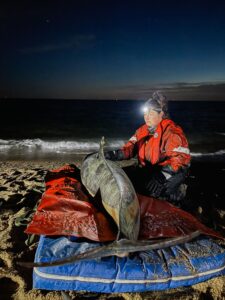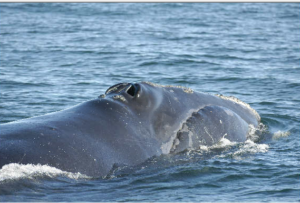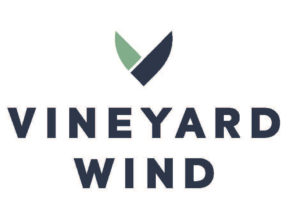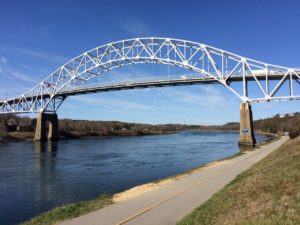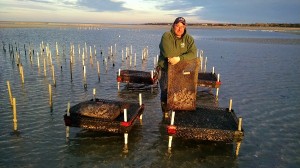
ROBERT SURRETTE PHOTOS
John Lowell puts several bags of oysters back into the sea to wake them up before they are sold.
By ROBERT SURRETTE
We were the only souls one January day when we visited John Lowell’s oyster farm about a half mile offshore from Crowe’s Pasture Beach. We were in shallow water that came half way up my boots and soaked the cuffs I forgot to tuck in. It was hard for this landlubber to walk on the sandy ridges that are strong enough to support Lowell’s truck.
“This is the best part for me,” Lowell said, “standing out here. Especially at this time of year when no one else is out here. Look at the colors in the sky. Sunsets are spectacular out here. A chimpanzee could do this job, a hard working chimpanzee. It’s not complicated. It’s just a lot of hard work.”
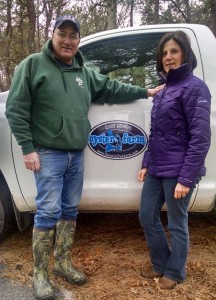
John and Stephanie Lowell, Owners of East Dennis Oyster Farm.
Lowell said that he loves his job. He can’t imagine a different life for himself. But unlike some other Cape Cod jobs, his work does not stop in the winter.
“We pull [the oysters] out of the water at the end of the growing season and store them for the winter,” he said. “It is quite a chore. There are about 400,000 of them this year and we moved them all within three days.”
Lowell owns East Dennis Oyster Farm with his wife, Stephanie. They each have a one-acre aquaculture grant on Cape Cod Bay. They’ve been at it since 2003.
Lowell’s oysters are stored for the winter in an insulated trailer, his “pit.” He opened a front hatch. “You can smell the freshness. It’s an unmistakable melon-y smell,” Lowell said.
The oysters spend summers in an area off Crowes Pasture Conservation Area in Dennis where they bask in the sun at low tide and soak up nutrients brought to them by the rising tides. They live in three-by-three-foot shallow containers fastened at four corners to small pipes anchored 18 to 24 inches deep into the sand. The oysters are loosely packed so that each of them has access to the flowing salt water from the Bay.
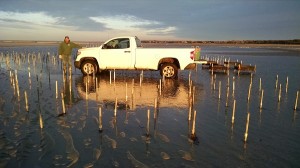
John Lowell stands beside his truck, seeming to float above the waters of Cape Cod Bay at low tide.
“We sell them year ’round,” Lowell said. “Today we are putting a few flats back into the ocean to wake them up. We need to keep some in inventory for sales.”
Stephanie Lowell added, “We also pay to keep 200 bags in the water at Sesuit Harbor as an alternate form of storage for the winter.”
As a licensed shellfish farmer Lowell leases an off-shore plot reachable by his truck at low tide. “We have to work with the tides and within the hours of daylight. The water will be 12 feet deep where we are standing,” he said when we visited his offshore “garden.”
“My wife, Stephanie, is not the farmer’s wife,” Lowell said. “She is my partner, my full partner. We farm together. I am very dependent on her good judgment and her skills in dealing with people.”
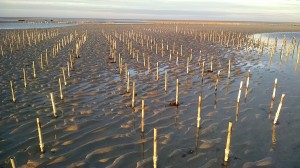
Poles erected in the shellfish grant await the return of John Lowell’s oysters
The Lowells have two adult sons who have turned their life-long love of the sea into their life’s work. Sam is in the Coast Guard and is stationed in New York. Robert, who graduated first in his engineering class at the Massachusetts Maritime Academy, works drilling for oil on the oceans’ bottoms.
“We focus on quality rather than quantity with our oysters,” Lowell said. “My saying is ‘More is not better. Better is better.’ Now we only sell the products we grow. We sell all we can produce. We regularly supply four restaurants in Dennis. We are also licensed to wholesale or retail directly to the public. During the season we operate a raw bar inside Chapin’s restaurant and the Summer Shanty.” They also supply Marshside and Chapin’s Fish and Chips.
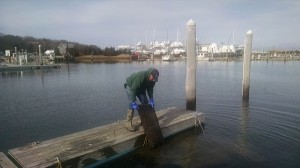
Checking on the oysters in winter storage in Sesuit Harbor.
Lowell said he insures the quality of his products by buying seedlings from a select supplier and scrupulously following all rules, regulations and laws. “Shellfish aquaculture is the most regulated farm product today. We have to track every batch. Everything is tagged and recorded,” he said.
“We produce solely for the half-shell market. The best part of my business is when we get to meet and know the people who are consuming our oysters,” Lowell said.
And yes, he told me with an almost imperceptible grimace, you can put sauce on them. “They are best if they are eaten raw, chew them up, and get the liquid, too,” he said.
He spoke of the many variables that go into an oyster’s flavor. “Oysters come in a lot of different tastes, depending on their type, where they are grown and all the variables of growing in the sea: weather, nutrients, shifting sands and good luck such as avoiding damaging storms,” he said. His brand are East Dennis Oysters, his own registered trademark product.
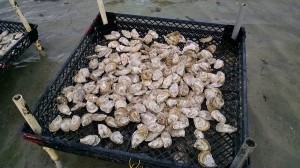
The finished product.
During the warmer months, Crowe’s Pasture Beach is bustling with other oyster farmers and beach goers. You can see other oyster grants, thousands of pipes in perfect rectangular rows and columns, in all directions from where we stood. Each grouping represents another farmer’s plot.
The road out to the oyster farms along Crowes Pasture’s bay frontage is a bumpy ride and to get out on the beach requires a special permit. There were no road signs when we left the beach and headed into the water in Lowell’s all-wheel-drive pickup.
“Never buy a used truck from an oyster farmer. They are constantly drenched in salt water,” he said.
Lowell is also a land farmer. He has an area south of Upper County Road where he has an organic gardening business. He uses no chemical fertilizers or pesticides.
“I just put in 2,000 garlic plants. They go on the opposite schedule of other crops. They are like daffodils. You plant them in the fall and harvest them in the spring. See, you can see some of them have started to come up already,” he said.
Lowell makes his own mulch. “You can see the heat coming out of that pile of horse manure. Isn’t it beautiful? Over there is the mountain of decomposing leaves that I will mix the manure with. Can you smell the manure? Smells great, no?” After a pause, Lowell revealed that he gets his horse manure from Melpet Farm.
Lowell moved to the Cape in 1983 and opened a landscaping business in 1985. Working the good earth is in his blood. “I like growing things on land and in the sea. Some people don’t know how much work goes into producing the food we eat. There’s lots going on they don’t see. There is perceived value in my product. My oysters compete well with the best that Cape Cod produces,” he said.
“I will continue to do this as long as I can,” Lowell said, and he had one final piece of advice, “It’s a myth that you should only eat oysters in months that have an ‘r’ in their names. They are healthy and delicious year around. Just don’t go looking for pearls. We do find some of them in our oysters. Very few.”






